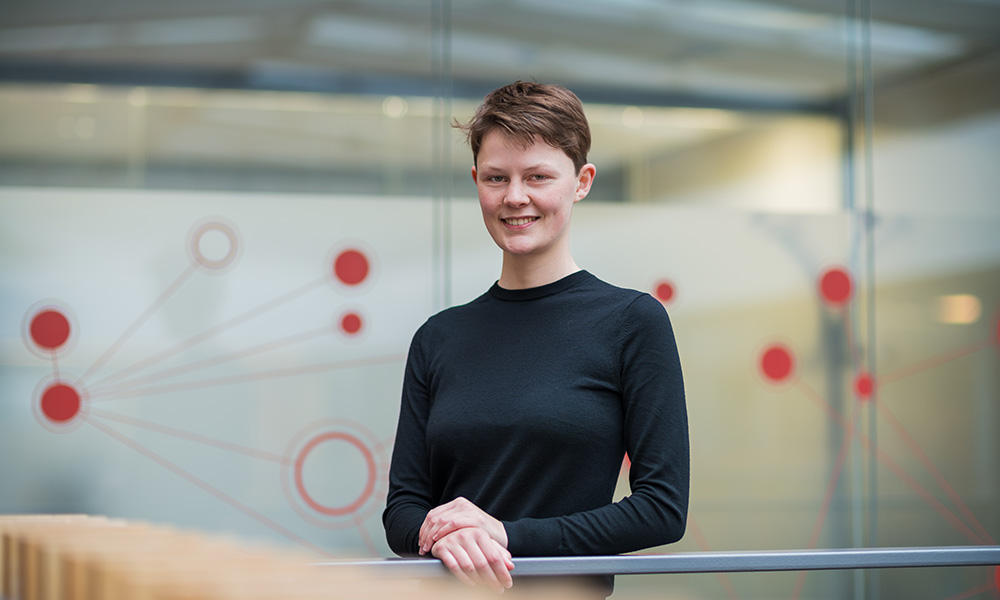
We are EMBL: Jacqueline Toussaint on strange bacteria and bioinformatics
Jacqueline Toussaint is a predoctoral fellow in the Lees group at EMBL-EBI, studying pathogenic bacteria. Here, she shares her experience of EMBL’s international PhD programme and her deep dive into the world of bioinformatics.

Tell us a little bit about your background.
I studied biochemistry with a minor in microbiology at Montana State University, USA. After my graduation in 2022, I was keen to get some hands-on experience and work on my own independent project, which is what attracted me to EMBL’s international PhD programme.
How has your experience in the EMBL PhD programme been so far?
I started in 2022, and so far it’s been great. It was a bit challenging in the beginning, because I didn’t come from a computational background, so I had to work hard to get my skills up to speed. However, my supervisor and colleagues at EMBL-EBI are super helpful and always willing to discuss my work and point me in the right direction if I’m feeling a bit lost. I value the supportive and open working environment at EMBL.
Two of the things I found appealing about the programme were, first, that there is no compulsory teaching element – which allows you to focus on your science – and second, that there are no rotations – so you can really concentrate on your project, without the work becoming too fragmented.
What are you currently working on?
I work on bacterial genomics with a focus on how we can better human health. Specifically, the main project I’m working on now focuses on developing methods for bacterial genome-wide association studies (GWAS). It aims to look at the genotype of a bacterium and correlate it with resulting phenotypes, or traits – for example, antimicrobial resistance or virulence (a microorganism’s ability to cause damage to a host).
The goal is to get a better scientific understanding of the causal genetic mechanisms of specific phenotypes. So these studies might then help you predict, for example, antimicrobial resistance for a bacterial sample you’ve isolated from a patient. This could have practical applications for guiding patient treatment in the future.
I’m currently working on a Bayesian model based on the theory of how bacterial genotypes and phenotypes are correlated. I’m using a pre-existing software called Stan in which anyone can implement their Bayesian model. If you input genotype and phenotype data into the model, it gives you an association score for each of the genetic variants and the phenotype. You can also input new query genotypes to receive a predicted phenotype that the genotype is likely to result in and an estimate of the heritability of the phenotype.
What data are you using to test the model?
I’m using public, open-source datasets, some of which are archived in EMBL-EBI’s European Nucleotide Archive. So far I’ve used datasets focusing on antimicrobial resistance because it’s heavily genetically based, which makes it a good phenotype to test with. I’ve tested the model using data from a few different bacteria, including Mycobacterium tuberculosis and Streptococcus pneumoniae.
Where does your interest in bacteria spark from?
I’ve always thought that bacteria make up some of the more interesting subjects of biochemistry because they can have so many improbable biological functions. Take extremophiles for example, which can live in hot geothermal springs or polar ice. When I learned about horizontal gene transfer – the movement of genetic information between organisms – it just blew my mind. For example, this process can enable the spread of antibiotic resistance genes among bacteria. I’m fascinated by the strange world of bacteria and the diversity that exists within it.
In EMBL’s 50th anniversary year, how do you think molecular biology is going to change in the future?
I think that the scale at which data is going to be produced, stored, and processed will be beyond our comprehension. It may also get easier to do bioinformatics. In the past, bioinformatics software often had a high barrier to entry and it could be extremely difficult to get even simple things done. I think, in the future, development might be as simple as plug ‘n’ play, which would open up the field to a lot more people.


